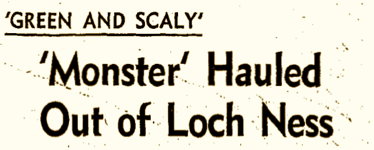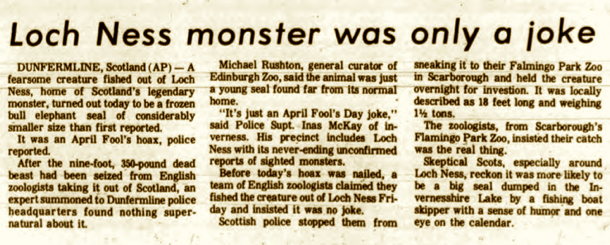On the morning of Friday March 31, 1972, an eight-member team of scientists from Yorkshire's
Flamingo Park Zoo was having breakfast in the dining room of the
Foyers House hotel, on the shore of Loch Ness. They were there on a joint mission with the Loch Ness Phenomena Bureau to prove the existence of a monster in the loch. They had developed a new form of "hormone sex bait" that they hoped would lure Nessie out of the depths.
As they dug into their bacon and eggs, the manager of the hotel approached them. Someone had just called, she said, to report seeing a "large hump" floating in the loch near the hotel. Intrigued, the team put down their knives and forks and walked outside. Sure enough, a large, dark object was bobbing up and down in the waves about 300-yards offshore.
Terence O'Brien, the leader of the team, immediately swung into action. He directed the team into their boat, and they headed out to investigate. Twenty minutes later, at around 9 a.m., they returned, dragging behind them a bizarre object. It appeared to be the dead body of the Loch Ness Monster.
Word Spreads
Within hours, news of the discovery had reached the rest of the world. Television news anchors solemnly informed their audiences that the Loch Ness Monster had been found, but was dead. Reporters rushed to the loch to get more details.
Local residents confirmed that something weird had been dragged out of the water. Robert MacKenzie, a 23-year-old Inverness musician, said, "I touched it and put my hand in its mouth. It's real, all right. I thought it looked half-bear and half-seal... green in color... with a horrific head like a bear with flat ears. I was shocked."
Other witnesses told reporters the creature had been between 12 and 18 feet in length and must have weighed up to 1½ tons. They said it had a green body without scales and was like a cross between a walrus and a seal.
Eventually reporters contacted Don Robinson, Director of the Flamingo Park Zoo, who said, "I've always been skeptical about the Loch Ness Monster, but this is definitely a monster, no doubt about that. From the reports I've had, no one has ever seen anything like it before... a fishy, scaly body with a massive head and big protruding teeth."
The next morning, April 1, the discovery made front-page headlines around the world. The British press dubbed the creature "Son of Nessie."

April 1, 1972 headline in the
Los Angeles TimesHigh-Speed Chase
Meanwhile, the creature itself was no longer at the Loch.
After dragging the carcass back to the shore, the scientists from the Flamingo Park Zoo had sent a telegram to their boss, Don Robinson, and had then quickly loaded the body into their truck and taken off, intending to transport the monster back to the zoo for study. Mrs. Margrete Good, manager of the hotel, later told the press, "The zoologists were thrilled to bits."
But when the local Inverness police heard that the scientists had hightailed it with the Loch Ness Monster, they were infuriated. These were English scientists, after all, removing Scotland's most famous lake monster — upon which depended a vast, lucrative tourist trade.
Immediately the police radioed their colleagues in the Fifeshire County police department, explained the situation, and asked them to chase down the fleeing truck and apprehend the monster-nappers. They cited a 1933 Act of Parliament that prohibited the removal of "unidentified creatures" from Loch Ness.
Sirens wailing, police cars sped off. They soon caught up with the team of scientists. The frightened zoologists readily cooperated with the police, pulling over to the side of the road, and then opening the back of the truck to show the officers what they were carrying. Sure enough, according to the subsequent police report, lying inside the truck was a large "green and scaly" creature.
The police officers, not quite sure what to do next, radioed back to the station for advice. They were told to take the monster to the nearest town, Dunfermline, where it could be examined by Scottish scientists.
The Monster Identified
In Dunfermline, the police searched around for an appropriate scientist to examine the creature, and eventually persuaded Michael Rushton, general curator of the Edinburgh Zoo, to come up and look at it.
When Rushton arrived, he walked slowly around the carcass a few times, poked it once or twice, and then announced his verdict. It was indeed a strange creature, but it was no lake monster. Instead, it was a bull elephant seal, whose natural home was the South Atlantic Ocean, thousands of miles away from Scotland. Furthermore, the body showed signs of having been frozen for an extended period of time.
Rushton told the press, "It is a typical member of its species. It's about 3 to 4 years old... I have never known them to come near Great Britain. Their natural habitat is the South Atlantic, Falkland Islands or South Georgia. I don't know how long it's been kept in a deep freeze but this has obviously been done by some human hand."
Confession
How a bull elephant seal came to be floating in Loch Ness remained a mystery until the next day, when a hoaxer stepped forward to confess. John Shields, the Flamingo Park Zoo's education officer, admitted it was his doing.
Shields explained that an expedition to the Falkland Islands had recently brought the seal back to the UK. It had lived briefly at the Dudley Zoo, but died soon after arrival. When he learned of this, Shields realized it offered an opportunity to prank his colleagues, who he knew were going up to Loch Ness to search for the monster.
Shields gained possession of the elephant seal, shaved off its whiskers, padded its cheeks with stones, and kept it frozen for a week. Then he dumped it in the Loch and phoned in a tip to make sure his colleagues found it. He timed the prank so that news of the discovery of the Loch Ness Monster would make headlines on April 1 — April Fool's Day, which happened to also be his 23rd birthday.

Headline from
The Geneva Times
Shields admitted the joke got out of hand when his colleagues decided to remove the dead animal from Loch Ness and were chased down by the police.
He also noted that the creature wasn't quite as impressive as initial press reports had claimed. It was only nine-feet long and weighed 350-pounds. Still, it had been a very strange thing to find floating in the Loch.
Police Superintendent Inas McKay of Inverness gave the press the final, official verdict on the incident: "It's just an April Fool's Day joke."
Epilogue
Having determined that the dead animal was not the Loch Ness Monster, the police had no further interest in it. So they returned the carcass to the team from the Flamingo Park Zoo. The team brought the seal back to the zoo, where they put it back on ice and displayed it to crowds for a few days before properly disposing of it.

The "monster" on display at the Flamingo Park Zoo
But this wasn't quite the end of the story. The prank turned out to have unintended consequences for other visitors to the loch. Two weeks later, 28-year-old Norman Slater, a school teacher from Kenosha, Wisconsin, went on a fishing trip on the Loch. While floating along, he dipped his hand into the water. He later said that, as soon as he did so, he detected, by means of his extrasensory perception, the presence of six large creatures in the water — a family of Loch Ness Monsters.
Slater said that he saw a particularly vivid image of a creature 70-90 feet in length, with a large neck and a slim, worm-like body. Its bottom portion was white while its top was dark brown and scaly. He said the creatures "seemed to be just lying around on the bottom." Slater also claimed to see images of underground passageways connecting the Loch to the sea.
But Slater was a victim of bad timing. He complained that, despite the obvious scientific importance of his vision, because of the recent April 1st prank he couldn't find any reporters willing to take him seriously.
Links and References
- "April Fool Joke On Loch Ness Misfires," (Apr 2, 1972), The Modesto Bee: A-4.
- "Green and Scaly Monster Hauled Out of Loch Ness," (Apr. 1, 1972), Los Angeles Times: 2.
- "Uses ESP: Detects family of Loch Ness monsters," (Apr 20, 1972). Manitowoc Herald-Times: 4-T.
- "A real Loch Ness Monster Discovered?" (Apr 1, 1972), The Eureka Times-Standard: 2.
- "Dead Loch Ness monster just so much bull seal," (Apr 1, 1972), Long Beach Independent Press-Telegram: A-18.
- "Loch Ness Finally Yields a Monster," (Apr 1, 1972), Utica Daily Press: 1.




Comments